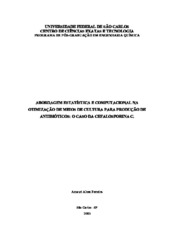Abordagem estatística e computacional na otimização de meios de cultura para produção de antibióticos: o caso da cefalosporina C.
Abstract
The scope of the current work was to investigate the effect of glucose, amonium acetate, DL-methionine, phosphorus, oleic acid and salt solution on the maximum specific growth rate (µmax), as well as the effect of sucrose and DL-methionine on the specific cefalosporin C production rate (µp), by Cephalosporium acremonium ATCC 48272, using factorial design and response surface techniques. The initial medium of fermentation was used according to factorial design and the experiments were carried out in shaker flasks at controlled temperature at 28 °C, initial pH of 7,0+0,1 and agitation speed 250 rpm. For both specific rate the variables involved were correlated by a fitted second order model. The canonic and surface response analysis showed a maximum specific growth rate of 0.22 h-1 obtained when glucose and amonium acetate concentration, were 4.2 , 2.5 g/L, respectively, and specific cefalosporin C production rate of 1.12 mgCPC/gcel.h when sucrose and DL-methionine concentration, were 10.5, 2.5 g/L, respectively, for a celular concentration of 14.0 g/L. The experimental design showed to be very efficcient in evaluating the bioprocess, as long as high values of µmax e µp were obtained in comparison
with literature data. The feedforward neural network (FNN) was employed for modelling and
simulation the effect of glucose, amonium acetate, DL-methionine, phosphorus, oleic acid
and salt solution on the maximum specific growth rate. The network topologies were used with 6 neurons in the input layer, 22 hidden layer and 1 output layer. The data base for training the FNN was obtained from results of the factorial designs processed with a backpropagation learning algorithm. The surfaces response obtained by simulations for all range of glucose and amonium acetate concentrations showed inhibitory effect for the two substrates on the maximum specific growth rate. The results of the simulation are in good agreement with the experimental and statistical model results.
